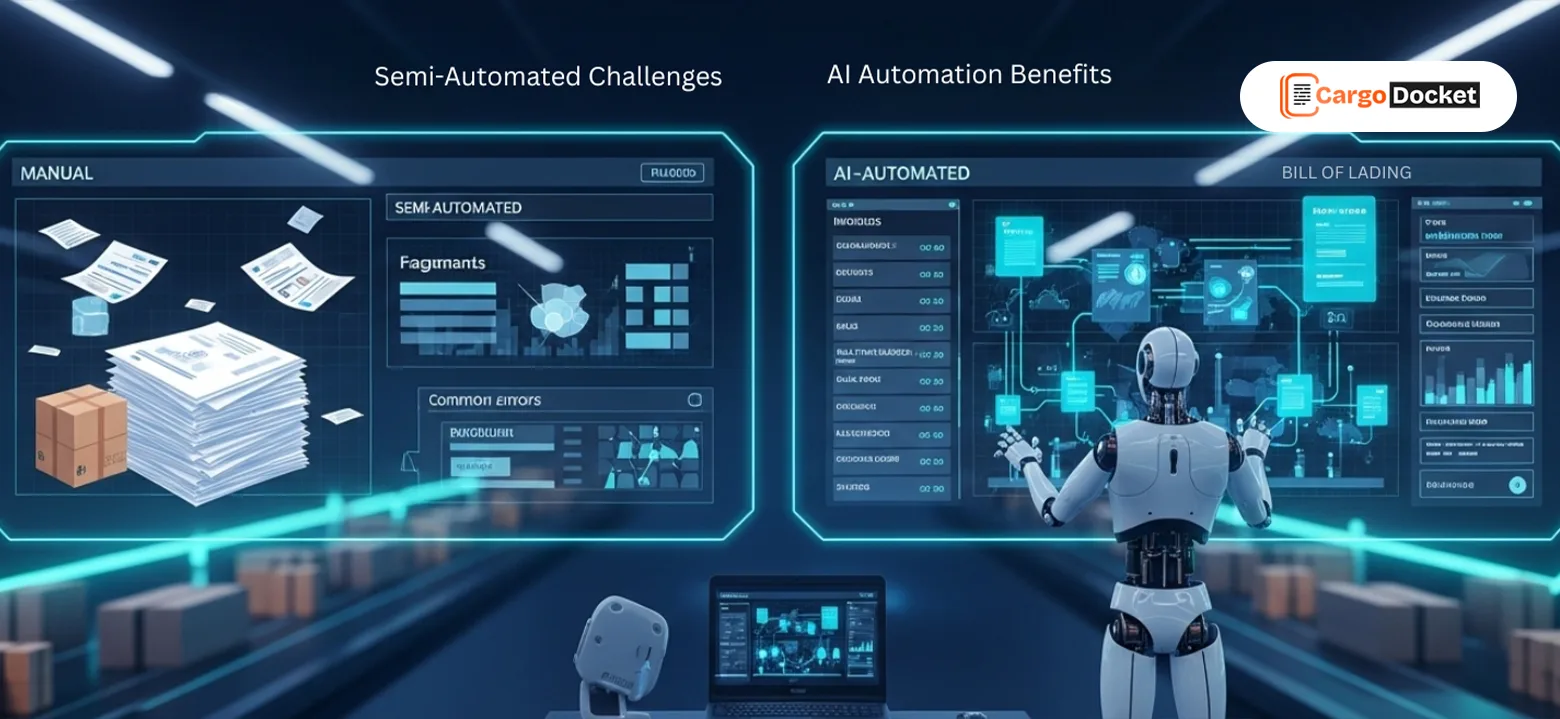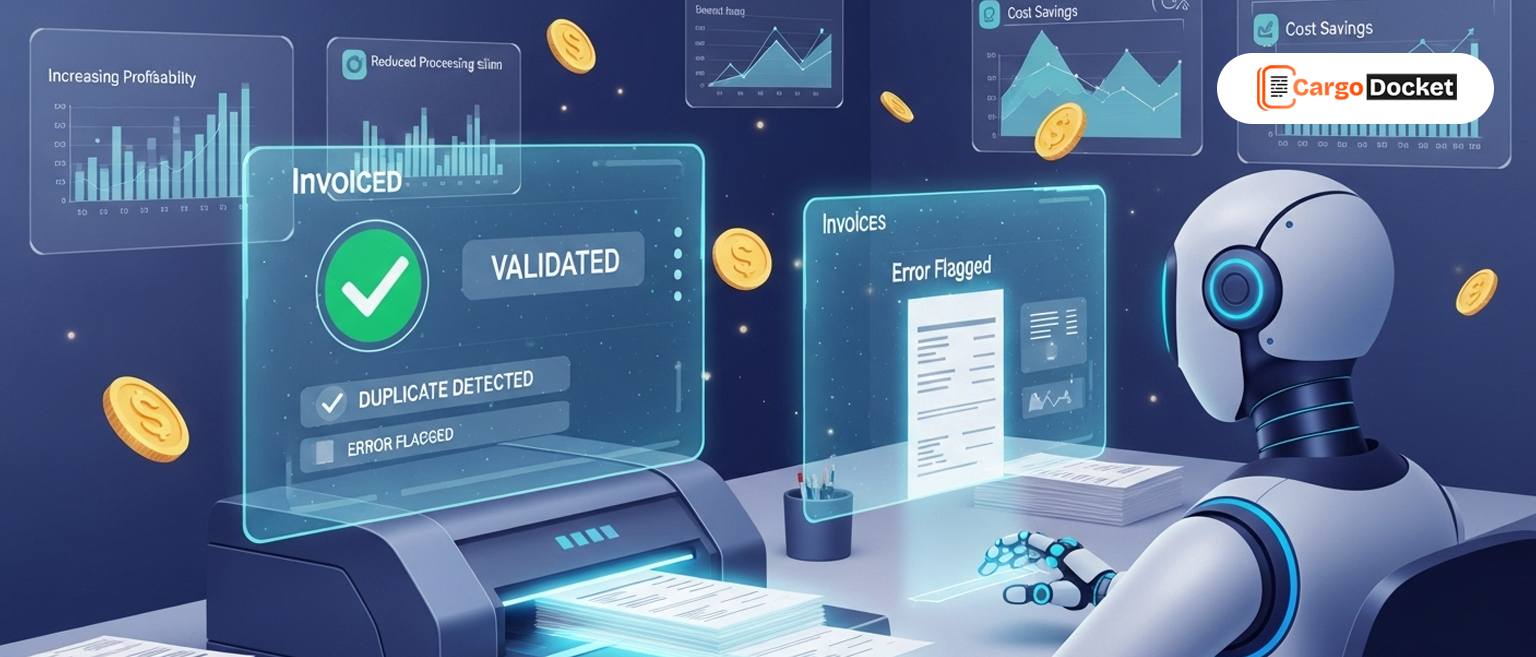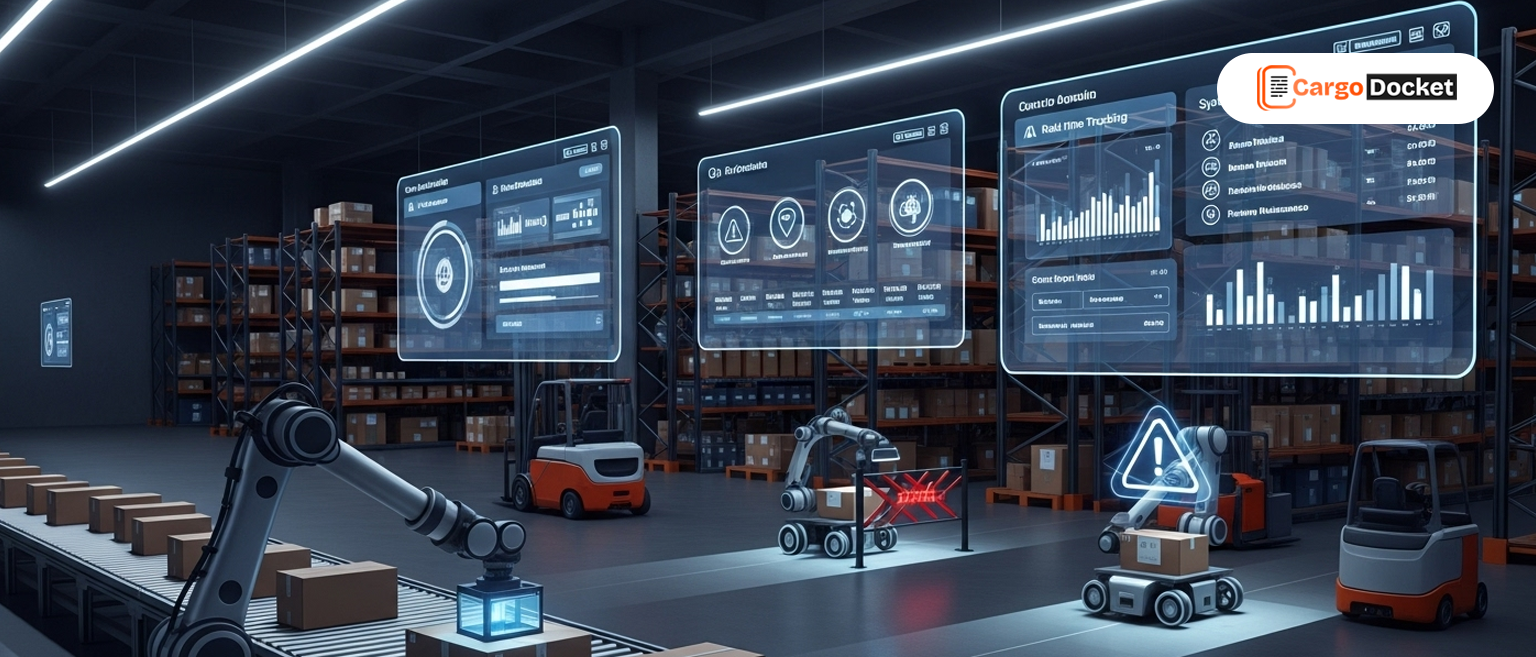Freight forwarding companies run on documents. Every shipment—import or export—comes with a trail of paperwork: bills of lading, invoices, job files, approvals, and emails with attachments. These aren’t just routine admin tasks. They take up time, cost money, and create space for errors.
You might not notice it right away, but manual document processing is silently draining your resources.
Let’s talk numbers:
📌 Processing a single freight document manually can cost anywhere from $6 to $25, depending on its complexity.
📌 If you’re handling 1,000 documents per month, that’s $10,000 or more gone every month—just to manage files.
But here’s the surprising part:
You can eliminate up to 80% of those costs without sacrificing accuracy. In fact, AI document automation helps reduce errors, speeds up your process, and gives your team time to focus on meaningful tasks—not just moving PDFs from inbox to system.
Where Does the Money Go? Let’s Talk About the Real Cost of Manual Freight Document Work
Many logistics teams think manual freight documentation is just part of the job. But few actually sit down to calculate what it costs them.
Here’s the breakdown for a typical freight forwarding company:
| Document Type | Time per Document | Estimated Cost | Common Issue |
| Import B/L | 10–15 minutes | $6–$10 | Inaccurate container details |
| Export B/L | 15–20 minutes | $10–$15 | Mismatched shipment data |
| Commercial Invoice | 20–25 minutes | $12–$18 | Incorrect totals or taxes |
| AP Invoice | 25–30 minutes | $15–$25 | Delayed payments, duplicate |
Now multiply that by hundreds—or even thousands—of documents every month.
“ The costs stack up fast. But the bigger issue is that it slows down your business, increases employee stress, and invites human error at every step.”
The Step-by-Step Reality: What’s Really Happening in Freight Offices Today for Freight Documentation Process
Let’s walk through what your team actually does when handling freight documents manually.
1. The Manual Workflow for Import Bill of Lading — One Click at a Time
- Open the email
- Download attachments
- Enter container details, job numbers, and references into ERP
- Double-check for errors
- Save and upload
- Time per doc: 10–15 mins
- Cost: $6–$10
- Common risks: Delays due to container mismatches or missing data
2. The Export B/L Process: More Copy-Paste Than You’d Like to Admit
- Pull shipment info from internal systems or emails
- Build House and Master B/L manually
- Match data with booking files
- Send out via email
- Time per doc: 15–20 mins
- Cost: $10–$15
- Common risks: Mismatched port names, late submissions
3. Commercial Invoices: The Silent Time-Eater in Your Daily Ops
- Read invoice line by line
- Key in product details, price, and totals
- Match with the correct job file
- Add taxes, incoterms, and remarks
- Time per doc: 20–25 mins
- Cost: $12–$18
- Common risks: Underbilling, customs compliance issues
4. The Accounts Payable Process That’s Slowing Your Team Down
- Receive vendor emails
- Download and open invoices
- Match with PO or vendor contract
- Enter data manually and route for approval
- Time per doc: 25–30 mins
- Cost: $15–$25
- Common risks: Delayed payments, duplicate entries, poor audit trail
Time to Turn the Tables — Here’s What Happens When You Adopt to AI Document Automation
Manual work isn’t just costly—it’s outdated.
Thanks to modern AI document automation tools like Cargodocket, logistics teams now have the ability to:
- Scan and extract data from email attachments in seconds
- Match that data against job files, POs, or bookings
- Auto-fill ERP systems without human input
- Reduce errors to almost zero
With automation in place, companies are seeing:
✅ Up to 80% cost savings
✅ 100% document accuracy in critical fields
✅ Faster turnarounds for both import and export shipments
✅ More focus on operations—not typing
Let’s go step by step again, but this time—powered by AI Document Automation.
1. Import Bill of Lading: What Happens When the System Does the Clicking
- Auto-detects the B/L from incoming email
- Extracts container numbers, job ID, consignee info
- Populates ERP job files automatically
- Flags errors in real time
- Time saved: ~12 mins
- Cost reduced to: ~$1–$2
- Result: Faster clearance and fewer delays
2. Export Documentation Without the Keyboard Clutter
- System identifies House vs Master B/L
- Pulls data from internal records
- Populates and formats B/Ls automatically
- Sends directly to client or carrier
- Time saved: ~18 mins
- Cost reduced to: ~$2
- Result: Clean exports and compliance-ready docs
3. Commercial Invoices That Fill Themselves (Yes, Really)
- AI reads invoice regardless of format
- Extracts all line items, taxes, totals
- Validates against job files
- Pushes to customs or finance portal
- Time saved: ~20–25 mins
- Cost reduced to: ~$2
- Result: Zero pricing errors, faster invoicing
4. AP Invoices, Approvals, and Peace of Mind — All in One Flow
- Captures invoice from email
- Matches to the correct PO
- Prepares and routes for approval
- Records into ERP without user input
- Time saved: ~25–30 mins
- Cost reduced to: ~$3
- Result: Faster payments, full compliance
Read More: To Know How does AI Document Automation Reduce Manual Errors in Freight Forwarding
Built by Freight Minds for Freight Teams: What Makes Cargo Docket Different
Unlike generic automation tools, Cargo Docket is built specifically for freight and logistics professionals.
Here’s why it works:
- Purpose-built for CargoWise and major ERPs
- Smart AI that understands real logistics docs—not just templates
- Fully automated from email capture to ERP update
- Minimal IT dependency — Easy to implement, even easier to use
- Backed by logistics experts who’ve worked inside freight offices, not just behind software screens
From import jobs to AP invoices, Cargo Docket takes the weight off your back office.
Let’s Do the Math: What Is Manual Processing Really Costing You Each Month?
Take a look at your document volume.
- 1,000 documents/month × 15 minutes avg. = 250 hours of work
- At $20/hour labor = $5,000/month just in processing
Now compare that to automate with help of CargoDocket – AI Document Automation:
- Cut that time by 80% = Only 50 hours of work
- Save over $4,000/month
And that’s just on labor—you also reduce errors, approvals lag, and delays that can cost thousands more.
It’s Time to Trade Stress for Speed — And Get Back to Freight
Freight forwarders are busy enough handling cargo, regulations, and customer expectations. The last thing your team should be doing is retyping PDFs, chasing down attachments, or fixing invoice mistakes.
By switching to AI document automation, you gain:
- Faster processing times
- Accurate, audit-ready records
- Leaner operations
- And more bandwidth to grow
You don’t need more hands. You need a smarter system.
Ready to Make the Shift?
Don’t let outdated document handling slow you down.
Visit Cargo Docket and Book your free demo and see how easy it is to bring AI Document automation into your freight operations.




